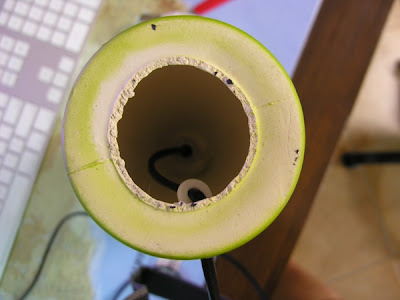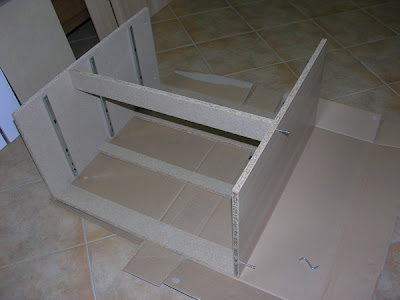So I bought a switch myself. It has to be one that's suitable for mains power, not every switch can do that. Pay attention to that if this inspires you to do the same!
 Right, so here's the lamp.
Right, so here's the lamp. And here's the switch. Good thinking huh?
And here's the switch. Good thinking huh? Top view of the lamp.
Top view of the lamp. Bottom view of the lamp.
Bottom view of the lamp. Remove the bottom first. This is ugly, sticky stuff that after removig can only be thrown away (in my case).
Remove the bottom first. This is ugly, sticky stuff that after removig can only be thrown away (in my case). When it's gone there's a nice hole left and we can admire the complicated inside (not).
When it's gone there's a nice hole left and we can admire the complicated inside (not). In the meantime back at the ranch; The Switch.
In the meantime back at the ranch; The Switch. The switch requires a hole to put it in. I bought nice special drill bits that are aparently made for glass and tiles. This is the big one...
The switch requires a hole to put it in. I bought nice special drill bits that are aparently made for glass and tiles. This is the big one... ... and this is the small one. I usually drill holes in 2 stages.
... and this is the small one. I usually drill holes in 2 stages. Drilling. The base of the lamp seemed to be made of clay, hardly baked at all, supersoft. Oh well.
Drilling. The base of the lamp seemed to be made of clay, hardly baked at all, supersoft. Oh well. I made a nice round hole. Ever noticed that when you drill with a metal drill the holes are actually triangular?
I made a nice round hole. Ever noticed that when you drill with a metal drill the holes are actually triangular? To be able to work properly we have to pull out the wires.
To be able to work properly we have to pull out the wires. This is tricky. The cord needs to be cut open. Get some wooden stick and put it through the wire effectively creating a cutting surface. Knowing that there are only 2 wires inside, place a knife in the middle and start cutting the wire open for about 5 cm. Make sure you stay in the middle otherwise you may damage one of the inside wires.
This is tricky. The cord needs to be cut open. Get some wooden stick and put it through the wire effectively creating a cutting surface. Knowing that there are only 2 wires inside, place a knife in the middle and start cutting the wire open for about 5 cm. Make sure you stay in the middle otherwise you may damage one of the inside wires. The result should be something like this.
The result should be something like this. Cut one of the wires in half. It doesn't matter which one because we're working with alternating current (meaning the + and - (ground) change usually 50 times a second (50Hz)).
Cut one of the wires in half. It doesn't matter which one because we're working with alternating current (meaning the + and - (ground) change usually 50 times a second (50Hz)). Strip the ends so that about 5 mm of copper is exposed.
Strip the ends so that about 5 mm of copper is exposed. Twist the ends together nicely so they seem 1 thick wire.
Twist the ends together nicely so they seem 1 thick wire. Put the ends in the switch and fix the wire very tight.
Put the ends in the switch and fix the wire very tight. Put the switch inside the lamp and make it stick out through the hole.
Put the switch inside the lamp and make it stick out through the hole. Put the switch-cover on and it's done!
Put the switch-cover on and it's done!






















































